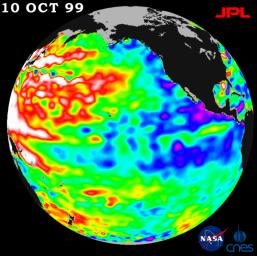A repeat of last year's mild La Niña conditions -- with a stormy winter in the Pacific Northwest and a dry winter in the southwestern United States -- will be the likely outcome of sea-surface heights observed by NASA's TOPEX/Poseidon satellite, scientists say.
TOPEX/Poseidon has detected lower than normal sea-surface heights in the eastern North Pacific and unusually high sea-surface heights in the western and mid-latitude Pacific. The height of the sea surface over a given area is an indicator of ocean temperature and other factors that influence climate.
The latest measurements, taken during a 10-day data cycle October 5-15, are available at http://www.jpl.nasa.gov/elnino . Sea-surface height is shown relative to normal (green) and reveals cooler water (blue and purple) measuring about 14 centimeters (6 inches) lower in the eastern North Pacific, from the Gulf of Alaska to central Alaska, and along the equator. The cooling trend sets the stage for another La Niña this winter.
"A mirror image of that oceanic profile prevails in the western and mid-latitude Pacific Ocean, where higher than normal sea-surface heights (red and white) are currently about 20 centimeters or 8 inches. Unusually warm temperatures (shown in red and white) have persisted and topped last year's temperatures," said Dr. William Patzert, an oceanographer at NASA's Jet Propulsion Laboratory, Pasadena, CA.
"These unbalanced conditions will undoubtedly exert a very strong influence on climate over North America this fall and winter," Patzert said. "Our profile of high sea-surface heights and warm temperatures in the western Pacific Ocean contrasts with low sea-surface heights and cool conditions in the eastern and equatorial Pacific. Those conditions will have a powerful impact on the weather system delivering jet streams out of the North Pacific."
Conditions are ripe for a stormy, wet winter in the Pacific Northwest and a dry, relatively rainless winter in Southern California and the Southwest, the data show. "Clearly, these unusual conditions, which have persisted for 2 1/2 years, will not be returning to normal any time soon," Patzert said. "This climate imbalance is big and we're definitely going through a decade of wild climatic behavior. But when we look back at the climate record over the past century, we've seen behavior like this before."
The TOPEX/Poseidon satellite's measurements have provided scientists with a detailed view of the 1997-1999 El Niño/La Niña climate pattern by measuring the changing sea-surface height with unprecedented precision.
For more information, please visit the TOPEX/Poseidon project web page at http://topex-www.jpl.nasa.gov/

 Planetary Data System
Planetary Data System












